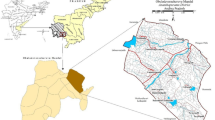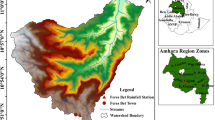Abstract
In the present study, soil loss in Nagpur district of Maharashtra is predicted employing USLE method and adopting integrated analysis in GIS to prioritise the tahsils for soil conservation and for delineation of suitable conservation units. Remote sensing techniques are applied to delineate the land cover of the district and to arrive at annual cover factors. Results indicate that potential soil loss of very slight to slight (>5–10 tons/ha/year) exist in the valleys in north western, northern and in the plains of central and eastern parts of the district. Moderate to moderately severe erosion rates (10 to 20 tones/ha/year) is noticed in the southeastern and some central parts. Severe, very severe and extremely severe erosion types (20 to 80 tons/ha/year) are noticed in the northern, western, southwestern and southern parts of the district. The average soil loss is estimated to be 23.1 and 15.5 tons/ha/yr under potential and actual conditions respectively. Slight, moderate, moderately severe and extremely severe potential erosion covering about 41 per cent area of the district is reduced to negligible and very slight rates of actual erosion under the influence of present land cover leading to a reduction of 7421.2 tones of potential soil loss. Priority rating of the tahsils is evaluated from the area weighted mean quantum of soil loss. Multi-criteria overlay analysis with the parameters of soil erosion, slope, soil depth, land cover and surface texture with rating for the constituent classes has resulted in delineation of nine conservation units. Appropriate agronomic and mechanical practices are suggested in the identified units for minimizing the erosion hazard.
Similar content being viewed by others
References
Anonymous (1990). Soils of Nagpur district, Maharashtra, Soil Survey Report No.514, Regional Centre, NBSS & LUP, Nagpur, India.
Ascough, J., Baffaut,C. Nearing, M.A. and Liu, B.Y. (1997). The WEPP watershed model: 1. Hydrology and erosion, Transaction of the American Society of Agriculture Engineering, ASAE,40(4): 921–933.
Bouma, J. (1989). Land qualities in space and time. In J.Bouma and A.K.Bregt (eds.), Proceedings ISSS symposium, Wageningen, PUDOC, Wageningen, pp. 3–13.
Challa, O, Vadivelu, S. and Sehgal, J. (1995). Soils of Maharashtra for optimizing land use. NBSS Publ. 54 (Soils of India Series), National Bureau of Soil Survey and Land Use Planning, Nagpur, India, 112p.
Desmet, P.J.J. and Govers, G. (1996). A GIS procedure for automatically calculating the USLE LS-factor on topographically complex landscapes. Journal of Soil and Water Conservation,51(5): 427–433.
Fournier, F. (1960). Climat et erosion. Presses Universitaires de France, Paris, 1.
Hamer, W.I. (1981). A Soil degradation assessment methodology, FAO Project in Tech. Note No.7. Report of Soil Cons. Consult. Soil Res. Institute, Bogor, Indonesia.
IMD (1971). Climate of Maharashtra., Pre published Scientific Report, 155p.
Khoram, S and John, A.B. (1991). A regional assessment of land use / land cover types in Sicily with Landsat TM data, Int. J. Remote sensing,12(1):69–78.
Renard, K.G., Foster, G.R., Weesies, G.A. and Porter, P.J. (1991). RUSLE — revised universal soil loss equation, Journal of Soil and Water Conservation, January–February, 1991, pp. 30– 33.
Requier, J. (1980). Small scale mapping of present and potential erosion. In De Boodt, M. and Gabriel, D. (eds.). Assessment of Erosion, John Wiley & Sons, pp. 23–29.
Roy, P.S, Ranganath, B.K, Diwakar, P.G, Vohra, T.P.S, Bhan, S.K, Singh, I.J. and Pandyan, V.C. (1991). Tropical forest type mapping and monitoring using Remote sensing, Int. J. Remote Sensing,12(11): 2205–2225.
Saraf, A.K. and Choudhary, P.R. (1998). Integrated remote sensing and GIS for groundwater exploration and identification of artificial recharge sites. Int. J. Remote Sensing,19(10): 1825–1841.
Singh, G., Rambabu and Subash Chandra (1981). Soil loss prediction research in India, ICAR Bull. T-12/D-9, CSWCRTI, Dehradun, India.
Wischmeier, W.H. and Smith, D.D. (1978). Predicting rainfall erosion losses — a guide to conservation planning, Agril. Hand Book No. 537, United State Department of Agriculture, USA.
Author information
Authors and Affiliations
About this article
Cite this article
Srinivas, C.V., Maji, A.K., Reddy, G.p.O. et al. Assessment of soil erosion using remote sensing and GIS in Nagpur district, Maharashtra for prioritisation and delineation of conservation units. J Indian Soc Remote Sens 30, 197–212 (2002). https://doi.org/10.1007/BF03000363
Received:
Accepted:
Issue Date:
DOI: https://doi.org/10.1007/BF03000363




